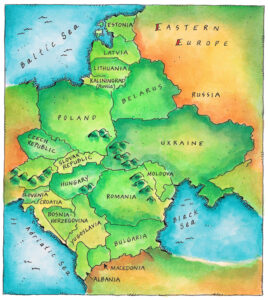
Protest Sparks Growing Tension in Ukraine

Last week, more than 70 people were killed and more than 500 injured in a anti-government protest gone horribly wrong. In the aftermath, Ukrainian President Viktor Yanukovych was removed from power by the nation’s parliament and is currently missing. The situation that sparked the controversy was a trade deal with the European Union (a collective made up of 28 member states located in Europe). On November 22, Yanukovych, who had pledged to sign a deal that many believed would have helped pull the Ukraine out of debt, changed his mind at the last minute. Many believed his change of heart was due to his unwillingness to pass necessary government reforms. In response, thousands flocked to Independence Square in the capital city of Kiev to protest.
Yanukovych had made several attempts to cease the demonstrations, including passing anti-assembly laws. This only enraged the protestors more. On January 22, a Ukrainian special police force called Berkyst fired shots at the protestors, but did not harm anyone. In mid-February, however, the forces were given permission to shoot at the protestors, which erupted into fighting that lasted several days and the bloodshed.
In an attempt to regain control, the Ukranian Parliament voted to restore the country’s 2004 constitution, impeached Yanukovych, released former Prime Minister Yulia Tumashenko (Yanukovuch’s rival) from prison, and issued a warrant for his arrest for “mass killings of civilians.” Since then, Yanukovuch has fled the country, the protestors are sill in place in Maiden and there are three main “opposition leaders” vying for leadership while Parliament decides how to proceed.
On Friday, Russian helicopters crossed the border into the Crimean region of Ukraine, which borders on southwestern Russia–near where the recent Winter Olympics were held. Reports have indicated that Russian troops moving into Ukraine are not wearing official military badges. Pro-Russian protest forces from Ukraine are surrounding some military bases in the Crimea region. Leaders from many nations, including the United States have spoken out against the Russian movement into Ukraine. President Obama made a brief statement at the start of the event last Friday.
Dig Deeper This story is likely to continue for some time. Make a timeline that includes both developments and pertinent statements from concerned parties, including any potential response from the United States or Europe.
Will You Accept the Art Assignment?
Last year, btw reported on the awesome adventures of the Vlogbrothers, who managed to raise more than $800,000 for charity. This year, brother John Green’s wife, Sarah Urist Green, is trying her hand at inspiring the masses with a new digital webseries called The Art Assignment. In collaboration with PBS Digital Studios, Green will travel around the United States, interviewing artists who will provide some sort of “assignment,” although the point of the show is more concerned with generating ideas over a finished product. Instead, the producers seek to “demystify the art-making process and offer a broader understanding of what art can be.”
As a former curator (a person who oversees art collections) for the Indianapolis Museum of Art, Green has met a number of innovative artists from all over the world. A growing awareness of social media led her to consider its impact on potential new audiences. PBS, the non-for-profit broadcasting network known for its educational programming, had approached John Green and his brother for ideas about reaching its audience. Sarah expressed and interest and pitched her idea to them. The Greens said they felt that PBS shared their passion for creating content that viewers will be passionate about supporting directly.
Dig Deeper Check out The Art Assignment’s YouTube Channel. There are now two assignments live. Watch at least one episode and participate in one assignment. How does it compare to previous (or current) exposure to art?
Detroit Bankruptcy Follow-up
Last summer, btw reported that the city of Detroit, Michigan had filed for bankruptcy. Last week, the city presented a “plan of adjustment” to a federal judge. This document lays out the city’s detailed plan on repaying the $18 billion in debt it still owes to more than 100,000 separate creditors. It also provided a budget structured to deliver basic city services to its residents. The plan also involves tearing down thousands of abandoned or dilapidated buildings and houses. To go in effect, the proposal must be approved by the federal judge.
Generating perhaps the most controversy is the city’s proposal to pay unsecured creditors as little as 20% of what they are owed. This includes retirement benefits for state workers, such as pensions and health insurance. There has also been a great effort to keep the city from selling off valuable paintings it keeps on display at the Detroit Institute of Arts. Philanthropic foundations have expressed interest in supporting this effort, but have expressed concern that too much of the money would go towards legal fees. Then there is a larger question of how Detroit plans to operate in the long term.
